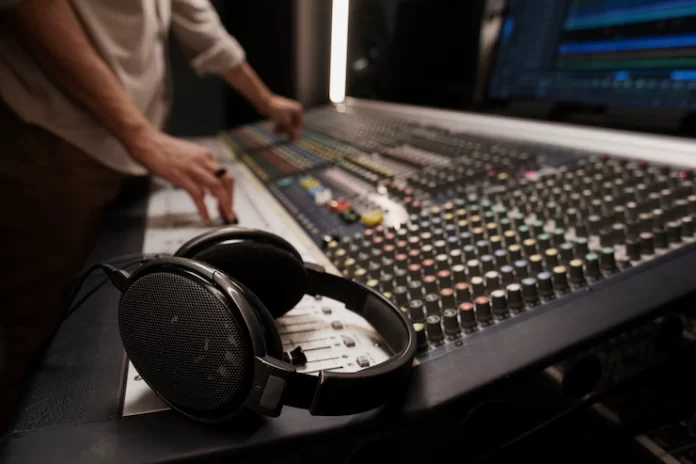Mixing is a crucial step in achieving a professional studio sound. It’s the final stage in the audio production process, where the goal is to optimize a mix’s overall balance, tonal quality, and dynamics before it’s ready for distribution.
The production sound mixer career in the US is also expected to grow by 10% between 2018 and 2028. So, many are interested in joining this industry.
If you’re the same, let’s explore various techniques and concepts to help you become a pro.
-
Table of Contents
Corrective EQ
Corrective EQ helps to balance the frequency spectrum, ensuring that no particular frequency range dominates or is lacking in the mix.
If vocals sound muffled, you can use corrective EQ to boost the presence or high frequencies to make them more transparent and defined.
Corrective EQ can improve the separation of different elements in the mix by carving out space for each instrument or vocal. You can cut low frequencies on non-bass instruments to prevent them from interfering with the bass.
Use a high-quality parametric EQ to make precise adjustments. Make subtle changes. Drastic EQ adjustments can negatively impact the mix.
-
Compression
Compression can make musical instruments and vocals sound more polished and smooth.
Adjust the attack time to control how quickly compression reacts to audio peaks. A fast attack can tame transients, while a slower attack lets some transients through for a more natural sound.
After setting the compression parameters, adjust the makeup gain to bring the overall level back to where it was before compression.
Compression has always been dreaded in the music industry because many don’t know its use.
So, it’s better to learn mixing at recording studios Melbourne. Book your session and learn all the significant things that will ever be useful. Let your music come to life in one of the finest studios.
-
Volume
By ensuring they sit prominently in the mix, volume control lets you emphasize the most essential elements in your mix, such as lead vocals, melody, or solos.
Use channel faders to adjust the volume of individual tracks. Start with a rough balance where no element is too loud or quiet.
Automate volume levels throughout the song to control changes in dynamics and highlight important sections. For example, raise the vocal volume during the chorus for added impact.
Group similar tracks, such as drums or background vocals, and control their collective volume using sub-mixes or busses. This allows for better overall control and cohesion.
-
Saturation
Saturation can add warmth and richness to audio, especially digital recordings that might sound too sterile or cold. It emulates the pleasing distortion characteristics of analog equipment.
It can also add crunch and make guitars more present. Light saturation on drum elements like snares and kicks can add punch and warmth.
Emulate the characteristics of tape saturation, known for its warm and smooth sound. Many plugins are designed specifically for this purpose.
-
Stereo Image
Proper stereo imaging creates a sense of space in your mix, making it sound more immersive and three-dimensional.
Pan individual tracks left or right in the stereo field to position them spatially. This creates separation between instruments and vocals and contributes to the stereo image.
Use mid-side processing to control your mix’s mono and stereo components separately. This can help you adjust the balance between centered and broader elements.
Consider using stereo microphone techniques to capture a natural stereo image at the source during recording.
-
Reverb & Delay
Reverb and delay create a sense of space within your mix, making it sound more immersive and realistic. This spatial enhancement can elevate your music and make it more enjoyable.
Reverb and delay also help create depth and dimension in your mix by placing audio elements at varying distances from the listener. This enhances the perceived size and scope of the soundstage.
When using delay, consider syncing it to the tempo of your song to create rhythmic effects that fit seamlessly with the music.
-
High-Pass Filter
Many instruments and tracks may contain unnecessary low frequencies that can accumulate, making your mix sound muddy or cluttered. High-pass filters help you control these issues.
Choose the cutoff frequency for your high-pass filter carefully. The exact frequency will depend on the instrument or track you’re working on.
You might start with a cutoff frequency of around 80 Hz on vocals to remove rumble and excessive low-end.
Or, start around 100-150 Hz on electric guitars to clean up unnecessary low frequencies.
For keyboards or acoustic guitars, start higher, around 150-200 Hz, to retain warmth while removing mud.
-
A/B Testing
A/B testing forces you to listen critically and attentively to your mix. It helps you identify subtle issues and nuances that might be missed through casual listening.
These tracks represent the quality and sonic characteristics you aim to achieve.
Ensure that the volume levels of your mix and reference tracks are matched closely to prevent volume bias.
Concentrate on specific elements in your mix, like vocals, drums, or instruments, during A/B testing to pinpoint issues or areas that need improvement.
CONCLUSION
Remember, there are more detailed techniques, and each plays a unique role in contributing to the final result. Begin with these steps, and you’ll get the ultimate music that resonates with your audience!
















